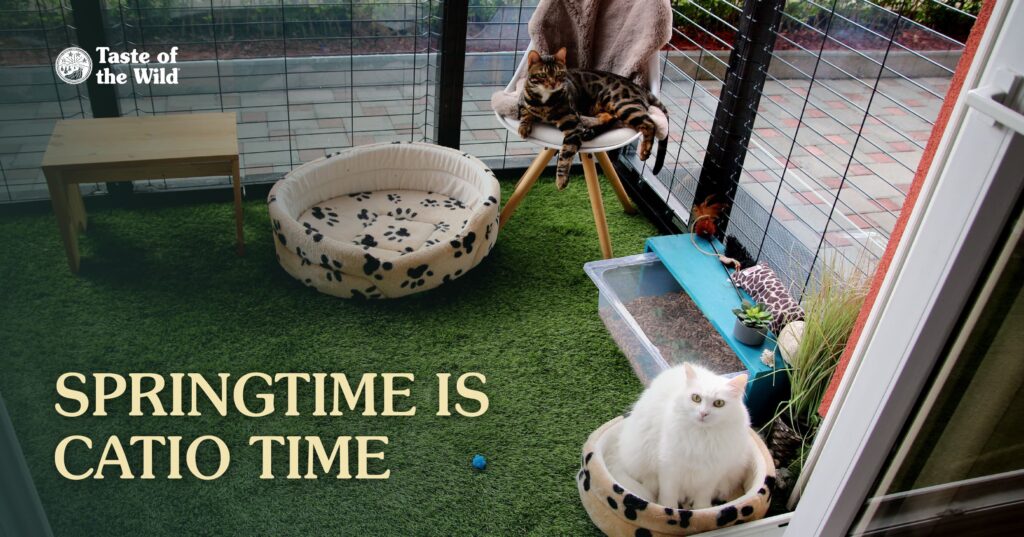
Is there better porch weather than spring weather? And is there a better purrson to share porch time with than your cat? Well, to make sure you both get the most out of your porch (or backyard, in lieu of a good sittin’ porch), here’s how to add a catio to your recreation area.
What’s a catio, you ask? Essentially, it’s a patio built with cats in mind. They come in all shapes, sizes and colors, depending on your space and preference. The only real requirement is that your catio is an enclosed space where your cat can enjoy the wonders of the great outdoors safely. They can be small window-set enclosures or giant free-standing play areas. Catios are something cats of all ages can enjoy.
How to Make the Right Catio for Your Cat and Home
You don’t have to have a big backyard or wraparound porch to make this cat dream work! You’ll find that there’s a catio layout for nearly every situation. This means you can make a catio work whether you’re in an apartment, duplex, house or otherwise.
First, if you’re renting your dwelling, we recommend getting permission from your property manager prior to getting started. There are catio options that are less permanent than others.
Next, choose the best location for your catio. This could be a window, an existing deck or a level spot in the backyard. Once you roughly know what dimensions you’re looking at, you can decide whether you want to buy a cat enclosure to assemble or build one from scratch. Cat enclosures are sold at most pet stores as well as online retailers like Amazon.
Building a catio from scratch can mean purchasing all new materials OR it could mean visiting your local Habitat ReStore and thrift shops for repurposed materials. Who knows, a refurbished chicken coop from the local thrift shop could be the starting point for your new catio! You don’t have to be a carpenter to build a catio, and you don’t have to break the bank crafting one either.
The main things to remember are that your catio is secured to the ground and/or side of the dwelling, and that there are no sharp edges or exposed nails that could harm your cat. We don’t want Mittens to escape or get hurt.
Don’t Forget the Decorations
Once you’re done building your cat enclosure, it’s time to decorate. Cats enjoy climbing and a bird’s-eye view. If your catio is big enough, add multiple perches, platforms and ladders. Also, place a blanket, cat bed or cat hammock in the enclosure for your furry feline to curl up and relax. Provide their favorite toys, a water bowl and a couple of treats.
Bonus tip: Add a birdbath or bird-friendly plants a safe distance from the catio so your feline has hours of birding ahead of them.
Introducing Your Cat to Their Oasis
It may take Mittens a week or two to fully get used to the new space. We recommend keeping an eye on your feline to determine when they need to go back inside. Each cat is unique, so you may notice during the first catio experience that Mittens is okay with 10 minutes or they may be alright with 30 minutes. Slowly work your cat up to spending more time in their catio.
Before you know it, they’ll be eager to enjoy their oasis for hours on end.
Benefits of a Catio
Think about the potential veterinary bills that come from a free-roaming cat. Cringe. Now, release a sigh of relief as you envision Mittens safe in their enclosure. Ahhhh. But that’s not the only benefit a catio can provide!
- A catio allows your furry companion to take in a variety of smells, sights and noises. This provides them an outlet for expending pent-up energy.
- Cats are the number-one threat to birds, so a catio is the perfect solution for protecting cats and birds alike. More birding for you and Mittens on the horizon!
- Like humans, cats can feel cooped up. When your pet can take in fresh air, they’ll be more relaxed and content.
- May reduce exposure to strays and the diseases they carry.
- A happy, healthy indoor cat is a cat with a longer life span. Yes, keeping your pet safe in a catio opposed to letting them roam the neighborhood increases your cat’s longevity.
- You get to introduce your furry friend to some of your favorite activities, like gardening or family BBQs.
So are you ready to get your cat into their new catio? We’re pretty sure your cat is ready! With the right amount of creativity and passion, you’ll have the perfect oasis for your cat in no time. Warmer weather, here you both come!
RELATED POST: Enrichment Tips to Keep Your Indoor Cat Happy


